History of Mongolia
This article needs additional citations for verification. (January 2015) |
| History of Mongolia |
|---|
 |
Various nomadic empires, including the Xiongnu (3rd century BC–1st century AD), the Xianbei state (c. AD 93–234), the Rouran Khaganate (330–555), the First (552–603) and Second Turkic Khaganates (682–744) and others, ruled the area of present-day Mongolia. The Khitan people, who used a para-Mongolic language,[1] founded an empire known as the Liao dynasty (916–1125), and ruled Mongolia and portions of North China, northern Korea, and the present-day Russian Far East.
In 1206,
After collapse of the Mongol-led Yuan dynasty in 1368, the Yuan court retreated to the
At the end of the 17th century,
Prehistory
The climate of Central Asia became dry after the large tectonic collision between the Indian Plate and the Eurasian Plate. This impact threw up the massive chain of mountains known as the Himalayas. The Himalayas, Greater Khingan and Lesser Khingan mountains act like a high wall, blocking the warm and wet climate from penetrating into Central Asia. Many of the mountains of Mongolia were formed during the Late Neogene and Early Quaternary periods. The Mongolian climate was more humid hundreds of thousands of years ago. Mongolia is known to be the source of priceless paleontological discoveries. The first scientifically confirmed dinosaur eggs were found in Mongolia during the 1923 expedition of the American Museum of Natural History, led by Roy Chapman Andrews.
During the middle to late Eocene Epoch, Mongolia was the home of many Paleogene mammals with Sarkastodon and Andrewsarchus being the most prominent of them.
The
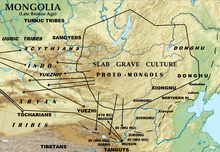
A vast Iron Age burial complex from the 5th-3rd centuries, later also used by the Xiongnu, has been unearthed near Ulaangom.[4]
Before the 20th century, some scholars assumed that the Scythians descended from the Mongolic people.[8] The Scythian community inhabited western Mongolia in the 5-6th centuries. In 2006, the mummy of a Scythian warrior, which is believed to be about 2,500 years old was a 30-to-40-year-old man with blond hair, was found in the Altai Mountains, Mongolia.[9]
In historical times Eurasian nomads were concentrated on the steppe lands of Central Asia.[10]
By the 8th century BC, the inhabitants of the western part of Mongolia evidently were nomadic Indo-European
With the appearance of iron weapons by the 3rd century BC, the inhabitants of Mongolia had begun to form clan alliances and lived a hunter and herder lifestyle. The origins of more modern inhabitants are found among the forest hunters and nomadic tribes of
Ancient period
This section needs additional citations for verification. (January 2015) |
The area of modern Mongolia has been inhabited by groups of
Xiongnu state (209 BC–93 AD)

The establishment of the Xiongnu empire in Mongolia in the 3rd century BC marks the beginning of statehood on the territory of Mongolia.
The identity of the ethnic core of Xiongnu has been a subject of varied hypotheses and some scholars, including Paul Pelliot and Byambyn Rinchen,[12] insisted on a Mongolic origin.
The first significant appearance of nomads came late in the 3rd century BC, when the Chinese repelled an invasion of the
The founder of the Xiongnu empire was
In 200 BC, the
The Xiongnu again raided northern China about 200 BC, finding that the inadequately defended Great Wall was not a serious obstacle. By the middle of the 2nd century BC, they controlled all of northern and western China north of the Yellow River. This renewed threat led the Chinese to improve their defences in the north, while building up and improving the army, particularly the cavalry, and while preparing long-range plans for an invasion of Mongolia.
By 176 BC, domain of the Xiongnu was 4,030,000 km2 (1,560,000 sq mi) in size.[13] Xiongnu capital (Luut; Dragon) located on the beach Orkhon River, Central Mongolia.[14]
Between 130 and 121 BC, Chinese armies drove the Xiongnu back across the Great Wall, weakened their hold on Gansu Province as well as on what is now Inner Mongolia, and finally pushed them north of the Gobi into central Mongolia. Following these victories, the Chinese expanded into the areas later known as Manchuria, Mongolia, the Korean Peninsula, and Inner Asia. The Xiongnu, once more turning their attention to the west and the southwest, raided deep into the Oxus Valley between 73 and 44 BC. The descendants of the Yuezhi and their Chinese rulers, however, formed a common front against the Xiongnu and repelled them.
During the next century, as Chinese strength waned, border warfare between the Chinese and the Xiongnu was almost incessant. Gradually the nomads forced their way back into Gansu and the northern part of what is now China's
The identity of the ethnic core of Xiongnu has been a subject of varied hypotheses and some scholars, including A.Luvsandendev, Bernát Munkácsi, Henry Howorth, Rashpuntsag,[15] Alexey Okladnikov, Peter Pallas, Isaak Schmidt, Nikita Bichurin and Byambyn Rinchen,[16] insisted on a Mongolic origin.
There are many cultural similarities between the Xiongnu and Mongols such as yurt on cart, composite bow, board game, horn bow and long song.[17] Mongolian long song is believed to date back at least 2,000 years.[18] Mythical origin of the long song mentioned in "Book of Wei (Volume 113).
In AD 48, the Xiongnu empire was weakened as it was divided into the southern and northern Xiongnu. The northern Xiongnu migrated to the west. They established
Recent excavations of Xiongnu graves at the site Gol Mod in the Khairkhan of Arkhangai province, discovered bronze decorations with images of a creature resembling the unicorn and images of deities resembling the Greco-Roman deities. These discoveries lead to a hypothesis that the Xiongnu had relations with the Greco-Roman world 2000 years ago.[19]
Xianbei state (147–234)

Although the Xiongnu finally had been split into two parts in AD 48, the Xianbei (or Hsien-pei in Wade–Giles) had moved (apparently from the east) into the region vacated by the Xiongnu. The Xianbei were the northern branch of the Donghu (or Tung Hu, the Eastern Hu), a proto-Mongol group mentioned in Chinese histories as existing as early as the 4th century BC. The language of the Donghu is believed to be proto-Mongolic to modern scholars. The Donghu were among the first peoples conquered by the Xiongnu. Once the Xiongnu state weakened, however, the Donghu rebelled. By the 1st century AD, two major subdivisions of the Donghu had developed: the proto-Mongolic Xianbei in the north and the Wuhuan in the south.
The
There are various hypotheses about the language and ethnic links of the Xianbei and the most widely accepted version suggests that the Xianbei were a Mongolic ethnic group and their branches are the ancestors of many Mongolic peoples such as the Rouran, Khitan and Menggu Xibei, who are suggested to be the proto-Mongols.[21] The ruler of the Xianbei state was elected by a congress of the nobility. The Xianbei used woodcut tallies called Kemu as a form of non-verbal communication. Besides extensive livestock husbandry, the Xianbei were also engaged on a limited scale in farming and handicraft. The Xianbei fractured in the 3rd century.
The Xianbei established an empire, which, although short-lived, gave rise to numerous tribal states along the Chinese frontier. Among these states was that of the
The Wuhuan also were prominent in the 2nd century, but they disappeared thereafter; possibly they were absorbed in the Xianbei western expansion. The Xianbei and the Wuhuan used mounted archers in warfare, and they had only temporary war leaders instead of hereditary chiefs. Agriculture, rather than full-scale nomadism, was the basis of their economy. In the 6th century, the Wuhuan were driven out of Inner Asia into the Russian[clarification needed] steppe.
Chinese control of parts of Inner Asia did not last beyond the opening years of the 2nd century AD, and, as the Eastern Han dynasty ended early in the 3rd century AD, suzerainty was limited primarily to the Gansu corridor. The Xianbei were able to make forays into a China beset with internal unrest and political disintegration. By 317 all of China north of the
Tuoba, a faction of the Xianbei, established the
Rouran state (330–555)

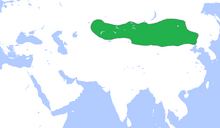
A branch of the Xianbei, the
Turkic period (555–840)
Turkic Khaganates (552–630, 682-744), Tang rule (646-682)
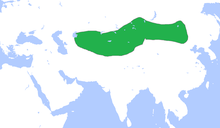
The Northern Wei in northern China was disintegrating rapidly because of revolts of semi-tribal Tuoba military forces that were opposed to being sinicized, when disaster struck the flourishing Rouran Khaganate. The Altai Turkics (Orkhon Turkics, Göktürks), known as "Tujue" to Chinese chroniclers, were subjects to the Rouran and served as blacksmiths for them. In 552 AD the Göktürks revolted against their Rouran rulers. The uprising began in the Altai Mountains, where many of the Türk were serfs working the iron mines. Therefore, the revolt of the Turkics of 552 is often called the "Blacksmiths' rebellion". The uprising was headed by Bumin, who became the founder of the Turkic Khaganate. Thus, from the outset of their revolt, they had the advantage of controlling what had been one of the major bases of Rouran power. Between 546 and 553, the Türks overthrew the Rouran and established themselves as the most powerful force in Central Asia.
The
For a brief period at the beginning of the 7th century, a new consolidation of the Türks, under the Western Türk ruler Tardu, again threatened China. In 701, Tardu's army besieged Chang'an (modern Xi'an), then the capital of China. Tardu was turned back, however, and, upon his death two years later, the Türkic state again fragmented. The Eastern Türks nonetheless continued their depredations, occasionally threatening Chang'an. In the early 8th century, an invading army of 450,000 soldiers headed by the Wu Zhou empress regnant Wu Zetian was defeated and chased back by Mojo Khagan.[21] The Türkic empire finally ended in 744 by the joint Chinese, Uighur and other nomadic forces.
Uyghur state (744–840)
The Uyghurs, who were subjects to the Göktürks, revolted in 745 and founded the Uyghur Khaganate which replaced the Eastern Turkic Khaganate. The Uyghur kagan Bayanchur established Ordu-Baliq City on the Orkhon river in 751. The Tang Empire invited the Uyghurs to subdue the An Lushan rebellion in 755. Successful campaigns of the Uyghur Khaganate led to a peace with the Tang dynasty of China which paid compensation for the suppression of An in silk and grain for 12 years after 766.[24] Though a faction of the Uyghurs were
The destruction of
Liao dynasty (916–1125)

The
The Liao dynasty soon grew strong and occupied parts of Northern China, including modern-day

The territory of the empire consisted of two parts: one populated by pastoral herders in the north and the other populated by croppers in the south. The two parts of the empire actively traded with each other. Lubugu, a grandson of Ambagyan, and a scholar named Tulyubu developed a Grand Alphabet based on the Chinese hieroglyphics in 920. Later, Tela, a son of Ambagyan, developed a Minor Alphabet based on the Uyghur script. A printing technology developed in the Liao territory. The Khitan language was widely studied abroad.
A Tungusic people, the Jurchens, ancestors of the Manchus, formed an alliance with the Song dynasty and reduced the Liao dynasty to vassal status in a seven-year war (1115–1122). The Jurchen leader Wanyan Aguda proclaimed himself the founder of a new empire, the Jin dynasty. Scarcely pausing in their conquests, the Jurchens subdued neighboring Goryeo in 1226[citation needed] and invaded the territory of their former allies, the Song dynasty, to precipitate a series of wars with the Song that continued through the remainder of the century.
The Liao dynasty fell in 1125. Some Khitans fled west under the leadership of
Medieval period
Confederations and khanates in the 12th century
12th-century Mongolia was characterized by rivalry between many tribes and confederations (khanligs or khanate). A confederation of tribes under the name Mongol was known from the 8th century. Some

The confederations of core Mongol tribes were transforming into a statehood in the early 12th century and came to be known as the Khamag Mongol confederacy. The people of Mongolia at this time were predominantly spirit worshipers, with shamans providing spiritual and religious guidance to the people and tribal leaders.
The Khamag Mongols occupied one of the most fertile areas of the country—the basins of the rivers
Yesukhei was poisoned by the Tatars in 1171 when his eldest son
In the 12th century the
The Tatar confederacy first appeared in recorded history in 732. The Tatars became subjects of the Khitan in the 10th century. After the fall of the Khitan empire, the Tatars experienced pressure from the Jin dynasty and were urged to fight against the other Mongol tribes. The Tatars lived on the fertile pastures around the lakes Hulun and Buir and occupied a trade route to China.
The
The
The
Consolidation of the Mongol state
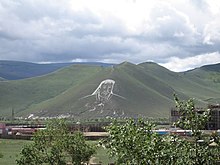
Temujin (1162–1227) defeated and subjugated the "
A conflict of the Tatars with the Jin dynasty became a favorable opportunity for Temujin and Tooril Khan to defeat them in alliance with the
In 1201, a crisis ignited in the Keraite khanlig, in which the siblings of Tooril Wang Khan allied with Inancha Khan of Naiman and defeated Tooril. Wang Khan regained power in his kingdom with the support of Temujin. Temujin finally defeated and subjugated the Tatars in 1202. Nilha (childish) Sengum, son of Wang Khan, envied Temujin as his power was growing and persuaded his father to battle against Temujin. This venture led to a victory of Temujin and conquest of the Kereit Khanlyk. Wang Khan escaped alone into the southern deserts of the Naiman khanlig, where he was caught by the Naiman patrols, who killed him irritated as he claimed himself as Wang Khan.
As the Khanlyk of Naiman was conquered,
By 1206, all the tribes and confederations of Mongolian steppe had come under the leadership of Temujin. The success of Temujin in consolidation of the
Formation of the Mongol Empire

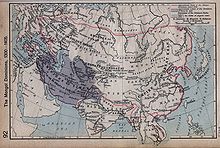
The Mongol Empire and the states that emerged from it played a major role in the history of the 13th and 14th centuries. Genghis Khan and his immediate successors conquered nearly all of Asia and European Russia and sent armies as far as central Europe and Southeast Asia.
Genghis Khan abolished the organization of the former tribes and confederations and reformed the country into 95 mingats. In this system, a group of households large enough to mobilize ten warriors was organized into an arbatu, 10 arbatus were organized into a zagutu (100 warriors), 10 zagutus constituted a mingat (1,000 warriors) and 10 mingats constituted a tumetu or tumen (10,000 warriors). This decimal system was a long-tested system that had been inherited from the period of the Xiongnu. With an assumption that each household consisted of four persons and every adult male was a warrior, it can be estimated that the entire population of Mongolia was at least 750,000 people and the nation possessed 95,000 cavalrymen.
The newly unified
In the year, the Mongols, with over 90,000 cavalrymen, started a war with the
Later, the warlord
Genghis Khan intended to develop friendly relations with the
The execution of 450 envoys and tradesmen of Genghis Khan by Khwarezm Shah 1218 was an announcement of war. The Mongol troops invaded Khwarezm Empire in 1219. Although Khwarezm Shah possessed an army outnumbering the Mongol troops dozen of times, he lacked the courage and initiatives to unite his forces and fight back.[
Pursuing Khwarezm Shah in 1220, the scout groups of warlords Jebe and
The Western Xia denied its obligation as a vassal state to take part in the western campaign of Genghis Khan. Shortly after returning to Mongolia, the Mongol army invaded the Western Xia in 1226 and conquered the capital Zhongxing (中兴府), located in modern Yinchuan. The Western Xia completely surrendered in March 1227.
Mongolic Khitans and Tuyuhuns or Monguor people (1227) came under rule of the Mongol Empire after its conquest of the Western Xia and Jin dynasties. The Qara Khitai (Western Liao) was conquered by the Mongols under Genghis Khan in 1218.
The 16-year conquests of Genghis Khan resulted in the formation of the Mongol Empire. He died on 16 August 1227 and was buried at site Ihe Ötög on the southern slopes of the
Mongol Empire and Pax Mongolica

The 1228 Congress of nobility known as

Ogedei Khan completed the conquest of the
After his 16-year reign, Ogedei Khan died in 1241 under suspicious circumstances. A rivalry for the throne began between the faction of the houses of Zuchi and
The traveller from Italy
Mönghe Khan died in 1259, without leaving behind a son. The Kuriltai of 1260 elected
The Mongol Empire had an establishing effect on the social, cultural and economic life of the inhabitants of the vast Eurasian territory in the 13th and 14th centuries. It enabled exchange of knowledge, inventions and culture between the West and East. This epoch is called Pax Mongolica.
In Mongolia, the legacy of Genghis Khan was a superior law code, a written language, and a historical pride.
Fragmentation of the Mongol Empire and Yuan dynasty
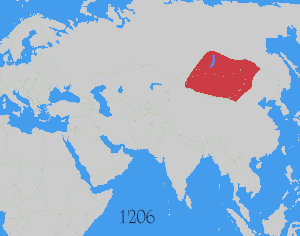
The establishment of the Yuan dynasty (1271–1368) by Kublai Khan accelerated the fragmentation of the Mongol Empire. The Mongol Empire fractured into four khanates including the Yuan dynasty based in China, and the three western khanates, i.e. the Golden Horde, the Chagatai Khanate and the Ilkhanate, although later Yuan emperors were seen as the nominal suzerains of the western khanates.
The transition of the capital of the Mongol Empire from
Kublai invited
Kublai Khan announced the establishment of the Yuan dynasty in 1271. The Yuan dynasty included modern-day Mongolia, the territories of the former Jin and Song dynasties and some adjacent territories such as a major part of southern Siberia. Kublai established a government with institutions resembling the ones in earlier Chinese dynasties such as the Zhongshu Sheng to lead the civil administration in the Yuan realm, yet at the same time introduced a hierarchy of reliability by dividing the subjects of the Yuan dynasty into four ranks. The highest rank included the Mongols, the second rank included the peoples to the west of Mongolia, the third rank included the subjects of the former Jin dynasty such as Northern Chinese, the Khitans and Jurchens, and the lowest rank comprised the subjects of the former Song dynasty such as the Han ethnic group in South China.

As for Mongolia itself, since the
Northern Yuan and Four Oirat
By 1368, the Mongols who established the
Biligtü Khan Ayushiridara was enthroned in 1370 after the death of the last Yuan emperor. The Ming dynasty founded by ethnic Han began aggressions against the Northern Yuan from the year 1372. Mongol warlord Köke Temür defeated a 150,000 Ming force on the river Orkhon in 1373. Ming army invaded the Northern Yuan again in 1380 and looted Karakorum and other cities, but the invasions of the Northern Yuan by Ming armies in 1381 and 1392 were expelled. Nevertheless, Yuan royalists in Yunnan had surrendered to the Ming dynasty by the early 1380s.
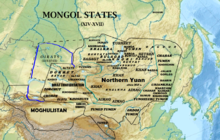
A long period of feudal separatism and rivalry for the Khan's throne started in Mongolia by the early 15th century. The military strength of the Mongols during the Yuan dynasty was that they were able to mobilize an army of 400,000 warriors (40 tumens). Assuming that an average household consisted of 4 people and every adult man was a warrior, it can be estimated that the Mongol population in the Yuan dynasty counted at least 1,600,000 people. However, the amount of 40 tumens remained only in the name of the Mongols after the fall of the Yuan dynasty as only 6 tumens were able to retreat to Mongolia and the remaining 34 tumens were lost to the Ming dynasty. These 6 tumens were grouped into the 3 tumens of the left wing ruled by the Mongol Khan and the 3 tumens of the right wing ruled by Jinong, vassal of the Khan. There were about 250,000 Mongols staying in South China and many of these Mongols who were unable to retreat to Mongolia were killed by the Chinese.[29]
The Oirats constituted another
The first half of the 15th century saw a rivalry of Oirat Taishis for the throne of the Khan and the second half of the 15th century saw a separatist movement of the Taishis in the right wing tumens.
In the late 14th century Mongolia was divided into two parts: Western Mongolia (
).Western Mongolian Oirats and Eastern Mongolian Khalkhas vied for domination in Mongolia since the 14th century and this conflict weakened Mongolian strength.

In 1434, Eastern Mongolian
The Khalkha emerged during the reign of Dayan Khan (1479–1543) as one of the six tumens of the Eastern Mongolic peoples. They quickly became the dominant Mongolic clan in Mongolia proper.[30][31]
Mongolia was once again unified under queen
Dayan Khan was succeeded by Bodi Alagh Khan whose power was however assumed by his uncle Bars Bolud Jinong as a regent due to the Khan's young age. As he grew up, Bodi Alagh claimed back his throne and the Jinong yielded.

The Mongols voluntarily reunified during Eastern Mongolian
Abtai Sain Khan, the ruler of Khalkha, conquered the Oirats in the 1570s, but the latter rebelled in 1588. The Oirats, in turn, were busy in struggle with Moghulistan for trade routes.
Tümen Jasagtu Khan was succeeded by
The striving of the Mongols to improve their life led naturally to an increase in the number of their livestock. In the
Cities in Mongolia were completely destroyed during Chinese raids in the late 14th and early 15th centuries. The Ming Empire attempted to invade Mongolia in the 14-16th centuries, however, the Ming Empire was defeated by the Oirat, Southern Mongol, Eastern Mongol and united Mongolian armies.[28] Thus there was no division of labor between urban and rural economies that was characteristic in other cultures. Some attempts of diversification of the economy were undertaken in the 16th and 17th centuries in peripheral Mongol domains but not in Northern Khalkha. Thus Altan Khan made Chinese grow grain around the city of Hohhot. Erdeni Batur Hongtaiji attempted to develop cereal and horticulture production in Dzungaria using imported Kazakhs, Kyrgyz, Chinese and Taranchis.[32] However, these initiatives mainly or exclusively served the ruling classes and the mass of the Mongol commoners received little or no benefit from them.

By the end of the 16th century, several Khanlig dynasties developed in Khalkha. As Dayan Khan divided Mongolia among his eleven sons, Northern Khalkha (approximately the territory of modern Mongolia) was given to his youngest son Gersenz Hongtaiji and Southern Khalkha was given to Alchibolad. Northern Khalkha was further divided among Gersenz's seven sons and their sons.
In the beginning of the 17th century, the
The third introduction of Buddhism
Hutuhtai Secen Hongtaiji of Ordos and his two brothers invaded Tibet in 1566. He sent an ultimatum to some of the ruling clergy of Tibet demanding their submission.[33] The Tibetan supreme monks decided to surrender and Hutuhtai Secen Hongtaiji returned to Ordos with three high ranking monks. Tumen Jasaghtu Khan invited a monk of the Kagyu school in 1576.[citation needed]

Following the advice of his nephew Hutuhtai Secen Hongtaiji, Altan Khan of Tumet invited the head of the Gelug school Sonam Gyatso to his domain. Upon their meeting in 1577, Altan Khan recognized Sonam Gyatso lama as a reincarnation of Phagpa lama. Sonam Gyatso, in turn, recognized Altan as a reincarnation of Kublai Khan.[34][citation needed] Thus, Altan added legitimacy to the title "khan" that he had assumed, while Sonam Gyatso received support for the supremacy he sought over the Tibetan sangha. Since this meeting, the heads of the Gelugpa school became known as Dalai Lamas. Altan Khan also bestowed the title Ochirdara (Очирдар, from Sanskr. Vajradhara) to Sonam Gyatso.
At the same time the ruler of
Cultural renaissance
The second half of the 15th and the 16th centuries saw the revival and flourishing of
An adopted son of Oirat aristocrat
In the area of historiography and literature, the Shira Tuuji was written in the 16th century, the Altan Tobchi of Lubsandanzan was written in the first half of the 17th century, and the Erdeniin Tobchi of Sagan Secen Hongtaiji (a descendant of Hutuhtai Secen Hongtaiji), was written in 1662. In the 1620s, Tsogtu Hongtaiji of Khalkha wrote his famous philosophic poems and Legdan Hutuhtu Khan had the 108 volumes of Kangyur and 225 volumes of Tengyur translated into the Mongolian language. A translation theory work, The Source of Wisdom (Мэргэд гарахын орон) was written under leadership of Rolbiidorji, Janjaa Hutuhtu II.
Qing dynasty
Qing conquests of Mongolia

In the early 17th century the

By the 1620s, only the Chahars remained under Ligdan's rule. The Chahar army was defeated in 1625 and 1628 by the Inner Mongol and Manchu armies due to Ligdan's faulty tactics.
Ligdan Khan occupied Tumet and Ordos in 1623 to forestall their absorption by the Manchu and advanced into the
Hong Taiji assumed the title of Khan of the Mongols in 1636, marking the conquest of Inner Mongolia. The Qing dynasty, supported by the troops of the Inner Mongolian taijis, conquered Ming dynasty in 1644.
Erdeni Batur Hongtaiji of the Dzungar Khanate convened a congress of Western Mongolian Dzungars and Khalkas in 1640 to ally their forces in struggle against increasing foreign aggression. The congress issued a Khalkha-Oirat Law called the "Great Code of the Forty and the Four" or "Mongol-Oirat Code" (Döchin Dörben Hoyar un Ike Tsagaza). The Congress was attended by 28 rulers from Dzungaria, Khalkha, Kukunor, and Kalmykia. Tushiyetu Khan Gombodorji and Secen Khan Sholoi were engaged in a conflict with the Manchu Qing dynasty siding with Tenggis Taiji of Inner Mongolia who revolted against Qing rule in 1646.
Chahundorji succeeded to Tushiyetu Khan's (Tusheet Khan) throne in 1665. Zasagtu Khan Norbo (Norvo) died in 1661 and rivalry started between his successors. This feud eventually involved Altan Khan, Tushiyetu Khan, and the Dzungar Khanate. The crisis continued for decades and evolved into a war between Khalkha and Dzungaria in 1688, leading to the conquest of Khalkha by Galdan Boshugtu Khan, king of the Dzungar Khanate, in the course of several battles in the Hangai mountains.
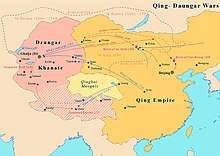
In 1688, Galdan attacked Khalkha following the murder of his younger brother by Tusheet Khan Chakhundorj (the main or Central Khalkha leader) and the Khalkha-Oirat War began.
The head of the Khalkha Buddhism Boghda Zanabazar, the Khalkha khans and nobles with thousands of their subjects moved in panic to Inner Mongolia, which had been integrated into the Qing dynasty. A few Khalkhas fled north of Outer Mongolia where Russia threatened to exterminate them if they failed to submit, but many submitted to Galdan Boshugtu. The Khalkha leaders sought Manchu aid in their feud with Galdan Boshugtu Khan while the Kangxi Emperor of the Qing dynasty cunningly demanded that they become his vassals as a condition for his support. Galdan demanded that the Kangxi Emperor cede him Önder Gegeen Zanagazar and Tushiyetu Khan Chahundorji. The Kangxi Emperor refused and decisive battle took place near UlaanBudan where Galdan was defeated and fled back deeper into Khalkha territory.
The Dzungar throne was then seized by Galdan's brother,
The Kangxi Emperor organized a congress of the rulers of Khalkha and Inner Mongolia in Dolnuur in 1691 at which the Khalkha feudatories (the Khalkha Khanate or Eastern Mongolia) by Zanabazar's decision formally declared allegiance to the emperor. However, Khalkha de facto remained under the rule of Galdan Boshugtu Khan. Chakhundorj fought against the Russian invasion of northern Mongolia until 1688. Zanabazar struggled to bring together the Oirats and Khalkhas before the war. Qing forces invaded Khalkha in 1696 and the Oirats were defeated by the outnumbering enemy in a battle at Zuun Mod at the river Terelj. Galdan Boshugtu Khan died in 1697 in the region of Kovd.
There were three khans in Khalkha of which Zasagt Khan Shar (Western Khalkha leader) was Galdan's ally. Tsetsen Khan (Eastern Khalkha leader) did not engage in this conflict. The Mongols who fled to Outer and Inner Mongolia returned after the war. Some Khalkhas mixed with the Buryats. Tsewang Rabtan continued the war against the Manchus to liberate Eastern,
Mongolia encountered Russian expansion on her northern border in the 17th century. The Buryats had fought against Russian
Teswang Rabtan stopped the eastern expansion of the Kazakh khans, and also sent his general Ihe Tserendondov to conquer Tibet in 1716. His force was driven out by Qing troops in 1720, who then occupied Tibet. However, several attempts by the Qing dynasty to subjugate the Dzungar Khanate failed in the early 18th century. In 1723, the Qing troops subdued the uprising of Luvsandanzan taiji in Kukunor. Tsewang Rabtan was succeeded by his son Galdan Tseren in 1727.
Galdan Tseren took a series of actions to develop of crop production, gardening, and cannon manufacture in Dzungaria. He successfully repelled the aggression of the Qing dynasty in 1729–31. Moreover, his general Baga Tserendondov advanced into Khalkha and reached the River Kerulen in 1732, but had to retreat after battles with Khalkha and Qing troops. Galdan Tseren died in 1745 and a crisis arose among his heirs. After a series of bloody clashes among them,
As soon as he became Khan, Dawachi deprived his friend Amursana of his wife and then defeated him in a battle in 1754. Amursana sought an alliance with the Qing dynasty, hoping to defeat Dawachi and elevate himself to the position of Khan of the Dzungar Khanate. The Qing administration mobilized horses and other livestock of the Khalkha population for the Dzungar invasion. A 200,000 strong army consisting of Khalkha, Inner Mongolian, Manchu and Chinese troops invaded Dzungaria in 1755. The vanguard of the Qing army was led by Amursana, king Chingünjav and King Renchindorji of the Khalkhas. The Dzungar Khanate was conquered by the Manchus in 1755–1758 due to conflicts between their leaders and military commanders.
While this horde entered the Ili River Basin, Amursana captured Davaachi and handed him to the Manchu. This event marked the fall of the Dzungar Khanate, which had impeded Qing expansion into Central Asia for over a century. The Qianlong Emperor demobilized the army and envisaged a congress of Dzungar and other Mongol aristocrats to celebrate the incorporation of Dzungaria into the Qing Empire.
Soon after the conquest of the Dzungar Khanate, Amursana, Chingünjav of
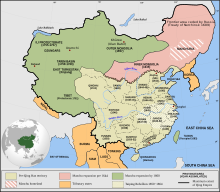
Chingünjav rose against Qing rule in 1756 abandoning his post and appealed to the other nobles of Khalkha to rise for independence. Around the same period, an uprising of Sevdenbaljir in Inner Mongolia was subdued. Sevdenbaljir was arrested before this uprising to prevent the Inner Mongols uniting their force. He planned to organize a congress of the Khalkha nobility to elect a future Khan of Mongolia. Chingunjav was supported by Boghda Gegeen II, the Khans of the four Khalkha aimags and other members of the nobility. However, the Qing court was able to capture Chingunjav before the uprising took its full swing. Chingunjav and his whole family were cruelly executed in 1757, and the Qing court decided that future Jebtsundamba Khutughtus would be only found in Tibet, not in Mongolia. Renchindorj Wang who allowed Amursanaa to abandon his post in the Qing army was cruelly executed in Beijing.
Amursanaa returned to Dzungaria with his 500 warriors as he was deceived in his hope to take the Dzungar throne with the support of the Qing Empire. A faction of the Oirat aristocrats elevated him as Khan of the Oirats in 1756. However, Amursana's followers lacked unity. The decisive battle took place at Sharbal in 1757 when 3,000 Oirat troops fought against a four times outnumbering enemy. After the 17-day battle, Amursana was defeated and fled to Tobolsk in Russia where he died but the Dzungars continued their war against Manchu invasion until 1758. Brutally revenging the Oirat people for their love for freedom, the Qing army carried out the Dzungar genocide, killing every Oirat they met on their way in the territory of the Dzungar Khanate. Of the 600,000 Dzungar population, only 30 thousand survived.[39] Some scholars estimate that about 80% of the Dzungar population were destroyed by a combination of warfare and disease during the Qing conquest of the Dzungar Khanate in 1755–1758.[40] Mark Levene, a historian whose recent research interests focus on genocide,[41] has stated that the extermination of the Dzungars was "arguably the eighteenth century genocide par excellence."[42] The territory of the Dzungar Khanate was then incorporated into the Qing Empire as Xinjiang, which later became a province.
Mongolia under Qing rule

After seizing control of Outer Mongolia, the Qing government grouped Khalkha khoshuns into 4 aimags (province): Tusiyetu Khan aimag, Zasaghtu Khan aimag, Secen Khan aimag and Sain Noyan Khan aimag. In addition, the territories populated by Oirats in the Kobdo region were grouped into Togs Huleg Dalai Khan aimag and Unen Zorigtu Khan aimag. Aimags were governed by aimag congress chigulgan comprising the lords of the khoshuns. The chigulgan daruga (чуулган дарга - official presiding the congress) was appointed from the khoshun lords by the Qing government.

As vassals of Qing Emperors, the Mongolian nobles—rulers of the khoshuns were expected to carry out military services commanding their troops in warfare, to personally attend the Emperor in his hunting processions,[43] mobilize resources from the khoshun population and subdue local riots. Their services were generously awarded by the Emperor, and those who performed exceptionally outstanding feats before the Qing Emperor would occasionally be honoured to marry a princess. Disobedience or failure to provide adequate service was severely punished.[43]
The most heavy burden of the foreign exploitation was laid on the spine of the ordinary Mongolian laborers. They were impoverished during mobilization of horses and livestock products during preparation of the military campaign against the
Modern period
Bogd Khanate (1911–1919)
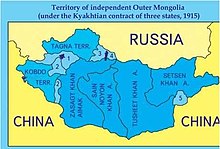
The official name of the state was "Ikh Mongol Uls", meaning the "Great Mongolian State". Yuan Shikai, the President of the newly formed Republic of China considered the new republic to be the successor of the Qing and claimed Outer Mongolia as part of its territory.[44] This claim was legally provided for in the Imperial Edict of the Abdication of the Qing Emperor signed by the Empress Dowager Longyu on behalf of the six-year-old Xuantong Emperor: "[...] the continued territorial integrity of the lands of the five races, Manchu, Han, Mongol, Hui, and Tibetan into one great Republic of China" ([...] 仍合滿、漢、蒙、回、藏五族完全領土,為一大中華民國).[45][46][47] The Provisional Constitution of the Republic of China adopted in 1912 specifically established frontier regions of the new republic, including Outer Mongolia, as integral parts of the state.[48] While the Qing referred to their state as Zhongguo (the term for "China" in modern Chinese) in official documents such as treaties, it implemented different ways of legitimization for different peoples in the Qing Empire, such as acting as Khan to the Mongols. As a result, the Mongols considered themselves as subjects of the Qing state outside China or Khitad, and the position of Mongols was that their allegiance had been to the Qing monarch, not the Chinese state. When declaring its independence the Mongolian government led by the Bogd Khan posited to Yuan Shikai that both Mongolia and China had been administered by the Manchus, but after the fall of the Manchu-led Qing dynasty in 1911 it was simply that the contract about their submission to the Manchus had become invalid.[49]


Bogd Gegeen was enthroned as Bogd Khaan (Holy King) of Mongolia on 29 December 1911 and a new era name, Olan-a Örgugdegsen (共戴; Gòngdài; lit. "Elevated by Many"), was declared. The Qing high official in Uliastai was deported on 12 January 1912 in the presence of 700 Mongolian warriors mobilized from Sain Noyan Khan aimag. Mongolian troops led by Danbijantsan (Ja Lama), Magsarjav, and the Manlaibaatar Damdinsüren arrived in the Khovd region in August 1912. After an intense attack supported by the local people, they captured the city of Kobdo during the night of 20 August 1912. At the same time, while many Mongol leaders outside Outer Mongolia sent statements to support Bogd Khan's call of Mongolian reunification,[50] in reality however, most of them were too prudent or irresolute to attempt joining the Bogd Khan regime.[51]
The Mongolian army took control of Khalkha and the Khovd region (modern
urged Russia to abolish Mongolian independence because it was concerned that "if Mongolians gain independence then Central Asians will revolt". [52] 10,000 Khalkha Mongolian and Inner Mongolian cavalry (about 3,500 Inner Mongols) defeated 70,000 Chinese soldiers and controlled almost all of Inner Mongolia, but in 1914 the Mongolian army retreated due to lack of weapons. 400 Mongol soldiers and 3,795 Chinese soldiers died in this war.The Barga Mongols fought against Chinese forces in August 1912, captured the city of Hailar, and announced their willingness to unify with the Bogd Khaanate.

In its historical significance, the establishment of the Bogd Khaanate of Mongolia is comparable with the foundation of the unified Mongol Empire in 1206. With national independence, Mongolia entered the path of modernization. A parliamentary structure consisting of two chambers, the Upper Hural and the Lower Hural, was formed in 1914. A legal code, Jarlig yar togtughaghsan Mongol Ulus un hauli zuil-un bichig (or Zarligaar togtooson Mongol Ulsyn khuuli zuiliin bichig), was adopted in 1915.
On 3 November 1912, the Russian Empire and Mongolia signed a bilateral treaty without the participation of China. This treaty meant recognition of the Bogd Khaan as the monarch of the sovereign "State of Mongolia" by Russia. Nevertheless, under strong pressure from the Russian and Chinese governments,
On 2 February 1913, Mongolia and Tibet signed a treaty of friendship and alliance. Mongolian agents and Bogd Khaan (he was a Tibetan) disrupted Soviet secret operations in Tibet to change its regime in the 1920s.
Chinese territory (1919–1921)
Following the Russian Revolution of October 1917, China revived its claims to Outer Mongolia, aiming at its conversion into a common Chinese province. In late 1919, the Chinese general Xu Shuzheng occupied Urga after suspicious deaths of Mongolian patriotic nobles and forced the Bogd Khaan and the leading nobles to sign a document renouncing Mongolia's independence. Leaders of Mongolia's national independence movement, such as Magsarjav and Damdinsüren, were arrested, imprisoned, and even tortured to death. The Chinese had tightened their control of Mongolia by this time.
Russian White Guard troops led by Baron von Ungern-Sternberg, who had been defeated in the Civil War in Transbaikalian Siberia, invaded Mongolia in October 1920. Baron Ungern sought allies to defeat the Bolsheviks. In October–November 1920, Ungern's troops assaulted the capital, Niislel Khuree, known to Europeans under the name Urga (now Ulaanbaatar), several times but were repelled with heavy losses. Ungern entered contacts with Mongolian nobles and lamas and received Bogd Khaan's edict to regain independence. On 2–5 February 1921, after fighting a huge battle, Ungern's force drove the Chinese forces out of the Mongolian capital.
One part of the Chinese forces fled to the south to China, and another to the north of Mongolia to enter negotiations with the Far Eastern Republic. The Bogd Khaan's monarchic power and his government were briefly restored.
